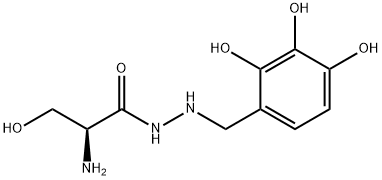322-35-0

COMPUTED DESCRIPTORS
| Molecular Weight | 257.24 g/mol |
|---|---|
| XLogP3 | -1.3 |
| Hydrogen Bond Donor Count | 7 |
| Hydrogen Bond Acceptor Count | 7 |
| Rotatable Bond Count | 5 |
| Exact Mass | 257.10117059 g/mol |
| Monoisotopic Mass | 257.10117059 g/mol |
| Topological Polar Surface Area | 148 Ų |
| Heavy Atom Count | 18 |
| Formal Charge | 0 |
| Complexity | 278 |
| Isotope Atom Count | 0 |
| Defined Atom Stereocenter Count | 0 |
| Undefined Atom Stereocenter Count | 1 |
| Defined Bond Stereocenter Count | 0 |
| Undefined Bond Stereocenter Count | 0 |
| Covalently-Bonded Unit Count | 1 |
| Compound Is Canonicalized | Yes |
PRODUCT INTRODUCTION
description
Benserazide is a carbohydrazide that results from the formal condensation of the carboxy group of DL-serine with the primary amino group of 4-(hydrazinylmethyl)benzene-1,2,3-triol. An aromatic-L-amino-acid decarboxylase inhibitor (DOPA decarboxylase inhibitor) that does not enter the central nervous system, it is used as its hydrochloride salt as an adjunct to levodopa in the treatment of parkinsonism. By preventing the conversion of levodopa to dopamine in the periphery, it causes an increase in the amount of levodopa reaching the central nervous system and so reduces the required dose. Benserazide has no antiparkinson actions when given alone. It has a role as an EC 4.1.1.28 (aromatic-L-amino-acid decarboxylase) inhibitor, an antiparkinson drug and a dopaminergic agent. It is a carbohydrazide, a member of catechols, a primary amino compound and a primary alcohol. It is a conjugate base of a benserazide(1+).